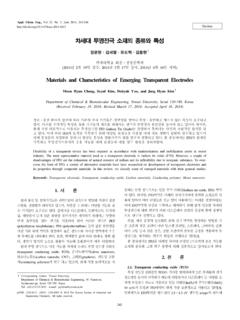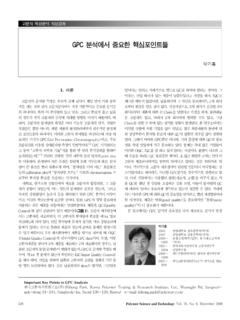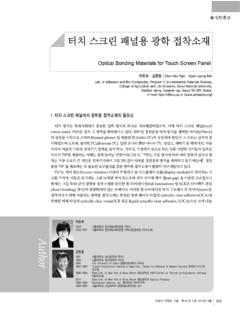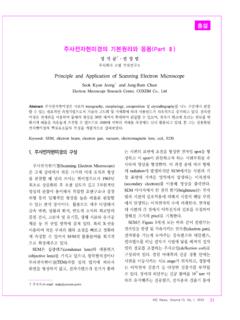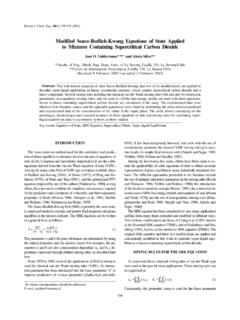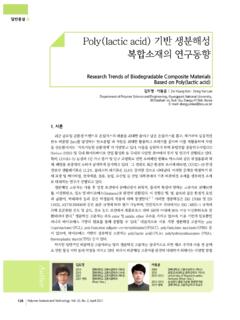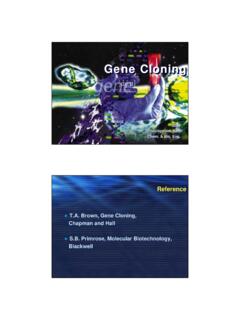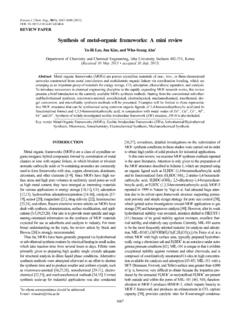Transcription of Introduction to Safety in Chemical Process Industry - CHERIC
1 Introduction to Safety in Chemical Process Industry - Chemical Process , Chemical Engineering, Safety /Risk/Hazard/Loss - Kyoshik PARK Department of Chemical Engineering Middle East Technical University - NCC 9/26/2011 METU-NCC 2 9/26/2011 METU-NCC 3 9/26/2011 METU-NCC 4 9/26/2011 5 METU-NCC Rev. Processes Involving Ideal Gas oSummary 9/26/2011 6 METU-NCC Isentropic Expansion dP F C12dP Incorporate friction term: C12dP PoP u 22 gc 0 Ideal gas, isentropic expansion: P = a, Cp/CvIntegrate and solve for u Mass flow rate: Qm CoAPo2gcMRgTo 1 PPo 2/ PPo ( 1)/ 9/26/2011 7 METU-NCC Exposure to Release , Diffusion 3. Gravity 4. Transition 6. Turbulence Predict effects of exposure near the surface. Predict % affected by the exposure.
2 Stages 3 4 5 6 1 2 9/26/2011 8 METU-NCC Gaussian Dispersion Pattern A: stack height B: effective height x y z (0,0,0) Cmax at center Isopleth Cmax Along X u9/26/2011 9 METU-NCC 9/26/2011 10 METU-NCC eeeeaozzzzppObjective How can it be prevented? Inerting Control static electricity Ventilation Explosion proof equipment Prevent the initiation of the fire or explosion and minimize the damage produced after it. 9/26/2011 11 METU-NCC Flammability Diagram - OSFC 9/26/2011 12 METU-NCC Pure N2 added till point S, OSFC A contains pure fuel Requires a large amount of nitrogen costly Pure N2 added till point S, OSFC the air forms a flammable mixture at the entry point 9/26/2011 METU-NCC 13 Patterns of two phase flow 9/26/2011 14 METU-NCC 9/26/2011 METU-NCC 15 Chemical Process & Chemical Process Industry Chemical Industry : Products Polyurethane mattress, polyester sheets Plastic clock, nylon carpet, phenolic switch Polyvinyl chloride insulated conductors Sanitized water, soap, refrigerants Fertilizers, printing inks, paper Electrical components in TV, radio Adapted.
3 Sanders, Chemical Process Safety , Butterworth-Heinemann (1999) 9/26/2011 16 METU-NCC Chemical Product Groups Food, shelter, health Electronics, computing, communications Biotechnology, pharmaceuticals Automobiles, appliances, furniture Paper, textiles, paint Agriculture, construction 9/26/2011 17 METU-NCC Chemical Industry : History I Early to 5,000 BC First industrial Chemical Process : fire Burning wood for heat, cooking food Firing pottery, bricks History adapted from: Sanders, Chemical Process Safety , Butterworth-Heinemann (1999) 9/26/2011 18 METU-NCC Chemical Industry : History II 3,000 - 4,000 BC Chemical : soda ash (sodium carbonate) Arabic name for soda: al kali Process : burning seaweeds & seashore vegetation including kali Hot water extraction to form brown lye Products: beads, glass ornaments, soap 9/26/2011 19 METU-NCC Chemical Industry : History III Prior to 3,000 BC Alcoholic fermentation Ale, wine (grapes, dates, palm), cider Egypt, Sumerian 9/26/2011 20 METU-NCC Early Living Standards 10th Century in Europe Life expectancy: ~ 30 years Food scarce, monotonous, often stale or spoiled Much labor required with few rewards Gradually the practice of science reduced the burdens of existence 9/26/2011 21 METU-NCC Chemical Industry .
4 History IV 17th and 18th Centuries Food preservatives (inorganic chemicals) Dyes, fabrics, soap Gunpowder First American Chemical plant in Boston, 1635, made saltpeter (potassium nitrate): gunpowder, tanning of hides 9/26/2011 22 METU-NCC Chemical Industry : Na2CO3 18th Century Nicolas LeBlanc Process (Paris, 1791) for soda ash from salt, NaCl. First large-scale Process HCl: first large-scale industrial pollution From 1861-1880 was gradually replaced by Solvay Process (simpler & less expensive) 9/26/2011 23 METU-NCC Chemical Industry : History V Modern Era After 1850: coal-tar dyes, drugs, nitroglycerin explosives Celluloid plastics, fiber Lightweight metals Synthetic rubber Fuels 9/26/2011 24 METU-NCC Chemical Industry : History VI 1930 s Neoprene, polyethylene, nylon, fiberglass After 1945 Rapid expansion of petroleum refining and Chemical Process industries Use, handling, & storage of chemicals presented more potential hazards 9/26/2011 25 METU-NCC Chemical Industry .
5 History VII After 1950 Chemical processing more disciplined Larger inventories, higher T, P conditions More emphasis on design & Process changes More review of effects from modifications Today: & European Chemical industries among safest of all industries 9/26/2011 26 METU-NCC What is a Chemical Engineer? a) An Engineer who manufactures chemicals b) A Chemist who works in a factory, or c) A glorified Plumber? d) None of the above (However, Chemical engineering students bored with the relentless pipe-flow example during fluid dynamics class may begin to think of themselves as simply glorified plumbers ) 9/26/2011 27 METU-NCC All Right, So What is a Chemical Engineer? Who are comfortable with chemistry . But they do much more with this knowledge than just make chemicals.
6 Who draws upon the vast and powerful science of chemistry to solve a wide range of problems. Sometimes described as the universal engineer 9/26/2011 28 METU-NCC So What Exactly Does This "Universal Engineer" Do? During the past Century, Chemical engineers have made tremendous contributions to our standard of living. To celebrate these accomplishments, the American Institute of Chemical Engineers (AIChE) has compiled a list of the 10 Greatest Achievements of Chemical Engineering. 9/28/2011 29 METU The Atom, as Large as Life: Ability to split the atom and isolate isotopes Biology, medicine, metallurgy, and power generation production of the atomic bomb use isotopes to monitor bodily functions accurately date their historical findings 9/28/2011 30 METU The Plastic Age: Mass produced polymers = Plastic Age A viable economic reality Bakelite -1908 - Electric insulation, plugs & sockets, clock bases, iron cooking handles, and fashionable jewelry 9/28/2011 31 METU The Human Reactor: Unit operations consisting of heat exchangers, filters, Chemical reactors and the like = Human body.
7 Improve clinical care Diagnostic and therapeutic devices Artificial organs 9/28/2011 32 METU Wonder Drugs for the Masses: Mutation and special brewing techniques increase antibiotics yields Low price, high volume, drugs enables. 9/28/2011 33 METU Synthetic Fibers, a Sheep's Best Friend: Keep us warm, comfortable, and provide a good night's rest Help reduce the strain on natural sources of cotton and wool tailored to specific applications. Nylon stockings make legs look young and attractive Bullet proof vests keep people out of harm's way. 9/28/2011 34 METU Liquefied Air, Yes it's Cool: Air separation Purified nitrogen; to recover petroleum , freeze food, produce semiconductors, or prevent unwanted reactions Oxygen; to make steel, smelt copper, weld metals together, and support the lives of patients in hospitals.
8 9/28/2011 35 METU 9/28/2011 36 METU The Environment Provide economical answers to clean up yesterday's waste and prevent tomorrow's pollution. Catalytic converters Reformulated gasoline Smoke stack scrubbers Synthetic replacements More efficient processing, and new recycling technologies 9/28/2011 37 METU Food, "It's What's For Dinner": Chemical fertilizers can help provide these nutrients to crops Forefront of food processing where they help create better tasting and most nutritious foods 9/28/2011 38 METU Petrochemicals, "Black Gold, Texas Tea": Form many useful products from petroleum by developing processes like catalytic cracking gasoline, lubricating oils, plastics, synthetic rubber, and synthetic fibers 9/28/2011 39 METU Running on Synthetic Rubber.
9 Developing today's synthetic rubber Industry During World War II, synthetic rubber capacity suddenly became of paramount importance. Tires, gaskets, hoses, and conveyor belts (not to mention running shoes) 9/28/2011 40 METU Chemical Engineering Today & Tomorrow The highest paid of the "Big Four" (civil, mechanical, electrical, Chemical ) Upper management position 3M, Du Pont, General Electric, Union Carbide, Dow Chemical , Exxon, BASF, Gulf Oil, Texaco, and Goodrich 70,000 practicing Chemical engineers in the United States 9/28/2011 41 METU 9/28/2011 METU 42 Safety & Process Safety 9/28/2011 METU 43 The superior man, when resting in Safety , does not forgot that danger may When all is orderly, he does not forget that disorder may come.
10 Confucius (551 BC 479 BC) 9/28/2011 44 METU 9/28/2011 METU 45 Basic Terms I Safety : prevention of loss incidents by identification, control, or elimination of hazards Hazard: A physical situation with a potential for human injury, damage to property, damage to the environment, or some combination of these Risk: The likelihood of a specified undesired event occurring within a specified period or in specified circumstances. Nomenclature for Hazard and Risk Assessment in the Process Industries - David Jones, UK Institution of Chemical Engineers, 1992 9/28/2011 46 METU Basic Terms II Risk deals with well defined events( ) about which norms have been negotiated amongst different stakeholders. Technology must be designed such that these norms are met.
